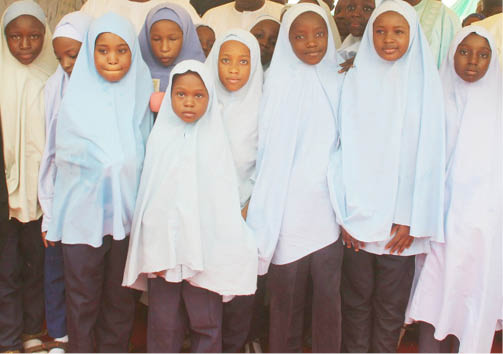Sokoto State has reportedly raised school enrolment campaign in renewed efforts to improve girls’ education and get at least one million more in school.
Over the years, there have been concern over low enrolment of girls and poor school attendance in Northern Nigeria which led to a number of interventions, including the Enrolment Drive Campaign (EDC) which has become an annual event aimed at encouraging parents and community members to send their school-age-children to school.
Enrolment Drive is also noted to be one of the interventions in the Girls Education Project (GEP3) geared towards increasing demand for education and enhancing access to deprived/marginalised children, especially girls.
At a planning meeting of stakeholders on 2018/2019 EDC in Sokoto State recently, Education Specialist, UNICEF, Sokoto Field Office, Safiya Tahir Abdullahi, while explaining the rationale of the campaign, said “despite the fact that primary education is officially free and compulsory, 10.2 million (UNESCO UIS database, based on 2010 data from Nigeria) children aged 5-14 years are not in school, of whom 8.7 million (4.98 million girls) are of primary school-age (6-11 years).”
She observed that educational marginalisation in northern Nigeria is particularly pronounced among women. “The DHS 2013 survey suggests that 69.4% of women in the North-west have no education at all, compared with 5.5% in the South-east and South-south geo-political zones.”
Safiya revealed the percentage of women with no education at all for each state of GEP3 to include Bauchi 62.3%, Katsina 67.7%, Niger 61.6%, Sokoto 78.5%, and Zamfara 77.3%.
“Comparisons with men’s educational attainment are instructive as 46.9% of men in the North-west have no education at all, whereas 62.8% of women did not. The low participation of girls in education is a major issue of concern in the northern states of Nigeria,” she stated.
She noted the disparity for girls’ education to be based on the struggle between socio-cultural beliefs, practices and perceptions of its value, hence the need to consistently advocate and campaign to grow school enrolment on an annual basis.
“The reasons why children and most especially girls are out of school in northern Nigeria are varied and rooted in the socio-cultural and economic environment which constructs barriers and bottlenecks to the educational success of girls and boys.”
The education specialist added that some of the barriers that inhibit girls’ ability to initially enroll in school were the biggest obstacle for their continued learning.
Other barriers, she said, prevent girls and boys from attending school regularly and becoming successful learners, ultimately resulting in them dropping out of school.
“Barriers influence the demand for education by parents and children and the educational choices that are made, such as the cost of education and negative perceptions of formal education. In addition, supply barriers compound the ability of girls and boys to access school, remain in school and learn successfully,” she added.
Hajiya Safiya also noted security as a concern, just as she expressed concern over teacher truancy, overcrowded classrooms and poor learning environments resulting in poor academic performance.
The Director Mobilisation, State Universal Basic Education Board (SUBEB), Kabir Aliyu, who gave an overview on the campaign in Sokoto, said the growth of school enrolment is essential to the attainment of the project outcome and more girls in the northern states would complete basic education and acquire skills for life and livelihoods.
On the number of schools to be covered by the project in funding the enrolment drive, he said: “The project covered 40% (812) of the total public primary schools in each of the GEP States, while the states were responsible for the remaining 60% (1,218) of the schools.”
The director recalled that during the previous years, the strategy was based on assigning resource persons to visit the schools/communities and mobilise parents/community members to send their children to schools for the new academic year.
“In 2014, the revised strategy involved the members of the SBMCs, as well as Mothers’ Associations (MAs) directly, by empowering them to conduct the EDC in their respective schools/communities,” he said.
The ultimate goal, the SUBEB director added, was for both SBMCs and MAs to be regularly tracking/monitoring attendance of enrolled children in their respective schools/communities, as one of their sole accountable oversight responsibilities.
SBMCs and MAs ensured on the spot registration/enrolment of the new-intakes, he explained.
“The idea of undertaking an on-the-spot registration is for the purpose of providing a total figure of the expected children upon resumption of schools. This was to forestall challenges encountered in the past when it became difficult to mop-up on demand, the total number of children enrolled through the enrolment exercise to buttress the issues of attribution as has always been the question of the donors,” he stated.
He however said for an improved EDC this year, education summit was held with Sultan Foundation and that pre-planning meetings at state level with Sultanate Council, district heads, local government officials, communities and schools would be conducted.
“The addition was necessary because education for all is the responsibility of all, we feel giving EDC a holistic approach will enable us achieve our desired objective,” he stated.
For her part, Communication for Development Specialist Sokoto Field Office, UNICEF Nigeria, Aye Aye Than, stressed that a mix of communication tools, channels and approaches were utilized in the campaign which included mass media, social media, face-to-face communication, individual counselling, community level motivation sessions, small group discussions, peer education, house-to-house visits, compound meetings, role plays, etc.
She said the campaign would also include street theatre, drama, storytelling and songs among others.
Aye described community empowerment as the key for sustainability of projects. “It promotes participation, which is intrinsic to any development project,” she said.
The communication objectives of EDC, Aye said was to inform and mobilise parents, local authorities, mothers, community influencers and family members to participate in enrolment campaign and to create and sustain demand for education.
According to her, expected outcomes of EDC include that parents, community leaders, SBMCs and MAs in all communities have increased awareness of the value of girls’ education and increased enrolment and attendance in all the communities in the state by at least 5% from the baseline of 2017/2018.




